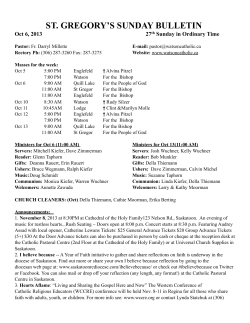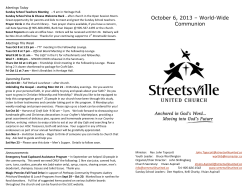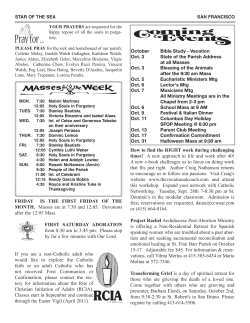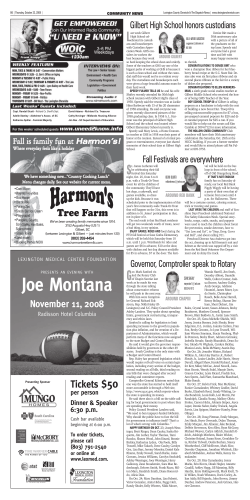
Michael Lewis, a member of Princeton's Class
A GRADUATION SPEECH Michael Lewis, a member of Princeton's Class of 1982 and author of such books as "Liar's Poker" and "Moneyball," speaks at the 2012 Baccalaureate in a speech called "Don't Eat Fortune's Cookie." http://www.youtube.com/watch?v=CiQ_T5C 3hIM PAY FOR LUCK from Mathews, Steve. (August, 2013) “Proving CEOs Overpaid for Luck Helped Stir Pay Backlash” Bloomberg.com http://mobile.bloomberg.com/news/2013-08-22/proving-ceosoverpaid-for-luck-helped-stir-pay-backlash.html University of Chicago Professor Marianne Bertrand found that a pay-for-luck phenomenon occurred with multinational businesses when currency fluctuations, rather than management strategies, improved results. Source: The University of Chicago via Bloomberg Marianne Bertrand helped unleash a shareholder backlash against CEO pay with research she began while still in graduate school. In a 2001 paper based on her work as a Ph.D. candidate at Harvard University, the 43-yearold labor economist documented that chief executive officers at U.S. oil companies got raises when their company’s fortunes improved because of changes in global oil prices beyond their control. The same pay-for-luck phenomenon occurred with multinational businesses when currency fluctuations, rather than management strategies, boosted results, she found. Books on Behavioral Economics For those interested in seeing a free book on the topic, click here to obtain a free download of Policy and Choice: Public Finance through the Lens of Behavioral Economics by William J. Congdon, Jeffrey R. Kling, and Sendhil Mullainathan. Bringing Behavioral Economics into the Classroom Alan B. Krueger Princeton University Why Should You Bring Behavioral Economics into the Classroom? • • • • • • • • Trains students to avoid making serious mistakes down the road (e.g., Don’t invest in your employer, Enron) Clarifies what is rational and irrational decision making Leads to a better understanding of opportunity costs, time discounting, and other economic concepts Provides leg up in the business world Provides a richer, more realistic understanding of decision making in practice Positive Economics Can lead to better policies (Pension Reform Bill) Normative Economics Easy to explain and demonstrate in class Oct. 13, 2006 Alan Krueger Elements of Rational Decision Making • • • • Utility = the amount of satisfaction a person gets from consuming a good. Utility can also be thought of as happiness (althought it technically goes beyond just happiness) Elements of decision-making Individuals make choices to maximize some objective function (usually utility function) under the constraints that they face Utility function is stable If there is uncertainty, individuals maximize expected utility by assigning probabilities to different states of the world Oct. 13, 2006 Alan Krueger Implications of Traditional Approach Compare opportunity cost of various decisions Pursue an activity until marginal benefit equals marginal cost Sunk costs are sunk Consistent behavior More choice is better Oct. 13, 2006 Alan Krueger assuming rationality has a very long history The quote is from Thorstein Veblen [(1898): pp. 389]: “In all the received formulations of economic theory… the human material with which the inquiry is concerned is conceived in hedonistic terms; …The hedonistic conception of man is that of a lightning calculator of pleasures and pains who oscillates like a homogeneous globule of desire of happiness under the impulse of stimuli that shift him about the area, but leave him intact.”(italics added to the original) Instrumental Rationality The traditional approach argues that people follow the dictates of “instrumental rationality”. “Players (i.e. economic actors or decision-makers) must not only have objectives, but know the correct way to achieve them. But how do the players know the correct way to achieve their objectives? The instrumental rationality answer is that, even though the actors may initially have diverse and erroneous models, the informational feedback process and arbitraging actors will correct initially incorrect models, punish deviant behavior, and lead surviving players to correct models.” Douglass North (1994) belief in rationality is difficult to defeat Dan Ariely – author of Predictably Irrational (2008) – highlighted the skepticism people have of experiments on his blog: “..after I gave a presentation at a conference, a fellow I’ll call Mr. Logic (a composite of many people I have debated with over the years) buttonholed me. “I enjoy hearing about all the different kinds of small-scale irrationalities that you demonstrate in your experiments,” he told me, handing me his card. “They’re quite interesting-great stories for cocktail parties.” He paused. “But you don’t understand how things work in the real world. Clearly, when it comes to making important decisions, all of these irrationalities disappear, because when it truly matters, people think carefully about their options before they act. And certainly when it comes to the stock market, where the decisions are critically important, all these irrationalities go away and rationality prevails.”” [www.predictablyirrational.com/?p=409; posted May 20, 2009]. Seinfeld disagrees with the rationality assumption! “…I must say, with all due respect, I find it very hard to see the logic behind some of the moves you have made with this fine organization. In the past 20 years you have caused myself, and the city of New York, a good deal of distress, as we have watched you take our beloved Yankees and reduce them to a laughing stock…” George Costanza upon meeting George Steinbrenner (owner of the New York Yankees): Seinfeld, “The Opposite” (season 5, 1994) “What the hell did you trade Jay Buhner for?! He had 30 home runs and over 100 RBIs last year. He's got a rocket for an arm. You don't know what the hell you're doin'!” Frank Costanza (George’s father) upon meeting George Steinbrenner: Seinfeld, “The Caddy” (season 7, 1996) The quotes from Seinfeld were found at www.seinfeldscripts.com. Behaviorial Economics • • • • • Fastest growing field in economics Behavioral economics is concerned with the ways in which the actual decision-making process influences the decisions that are made in practice; combines psychology and economics Assumes bounded rationality – meaning that people have limited time and capacity to weigh all the relevant benefits and costs of a decision. Decision making is less than fully rational. People are prone to make predictable and avoidable mistakes. At the same time, decision making is systematic and amenable to scientific study. Oct. 13, 2006 Alan Krueger Bounded Rationality: Thinking Is Costly • • • • • • Example of Bounded Rationality A baseball and bat together cost $11. The bat costs $10 more than the ball. How much does the ball cost? Write down your answer. Half of Harvard students said $1, which is the intuitive answer but wrong! Correct answer is 50 cents: $10.50-$.50 = $10.00 Lesson: People tend to use “intuitive thinking” or rules of thumb Oct. 13, 2006 Alan Krueger SIX KEY IDEAS FROM BEHAVIORAL ECONOMICS 1. Letting Sunk Costs Matter. Allowing sunk costs, which have already been paid and do not affect marginal costs regardless of which option is chosen, to affect a decision. 2. Overconfidence. Believing you will know what will happen in the future to a greater extent than is justified by available information. Overconfidence also creates a disconnect between perceived skills and actual skills. 3. Status Quo Bias. A tendency to make decisions by accepting the default option instead of comparing the marginal benefit to the marginal cost. 4. Faulty discounting. Being too impatient when it comes to decisions that involve benefits that are received in the future or discounting future benefits inconsistently depending on when the delay in receipt of benefits occurs. 5. Framing. Allowing the way a decision is presented to affect the choice that is selected even though the marginal benefit and marginal cost are unaffected. 6. Desire for Fairness and Reciprocity. A tendency to punish people who treat you unfairly and to reward those who treat you fairly, even if you do not directly benefit from those punishments and rewards. Behavioral Economics recognizes that people respond to incentives, but their response is not always a rational one. Alan Krueger Oct. 13, 2006 Status Quo Bias ◦ Decision-makers have an overwhelming tendency to adopt defaults, to stick with the status quo ◦ Even when the decision is important and the stakes are large ◦ Even when the decision-maker is told that the default is suboptimal ◦ Examples from 401(k) plans: participation, savings rate, asset allocation (company stock). ◦ Other examples: insurance deductibles, organ donation Alan Krueger Oct. 13, 2006 Example: Brigitte Madrian and Dennis Shea (2001) • Design: A Fortune 500 Company Switched 401(k) default on April 1, 1998. Madrian and Shea examine behavior of new hires. OLD NEW ◦ Default Contribution: Must actively sign up ◦ Default Contribution: 3 percent of compensation deducted for plan ◦ Default Allocation: None ◦ Default Allocation: Money Market Fund Alan Krueger Oct. 13, 2006 401(k) Participation Increases Percent at Specified Contribution Rate 80% 60% Before Automatic Enrollment 40% After Automatic Enrollment 20% 0% 0% 1-2% 3% 4-5% 6% 7-9% 10% 11-14% 15% Contribution Rate Alan Krueger Oct. 13, 2006 Source: Madrian and Shea (2001). Policy Application: Pension Reform Bill of 2006 The 900-page Pension Protection Act of 2006 comes as the number of people covered by a definedbenefit pension has steadily declined and awareness has grown about the lack of adequate savings among Americans. A majority of workers 45 and older have less than $50,000 in savings, according to a survey by the Employee Benefit Research Institute (EBRI). What's more, almost 40 percent of workers over 40 don't participate in a 401(k) when they are eligible. The new legislation encourages companies to automatically enroll 401(k)-eligible employees and to automatically increase worker contributions every year. It also allows the plan provider chosen by the employer to offer investment advice to workers. Automatic enrollment is expected to boost the participation rate in 401(k) plans beyond 90 percent. By Jeanne Sahadi, CNNMoney.com Alan Krueger Oct. 13, 2006 Libertarian-Paternalism: Set the default to help people, but they can opt out. More on Status Quo Bias http://www.wired.com/wiredscience/2011/ 04/the-messy-reality-of-judicial-decisions/ ◦ When a judge hears a case impacts the decision. ◦ Tired brains choose the status quo. Overconfidence ◦ People tend to think they are above average!! ◦ a survey at the University of Nebraska revealed that 94% of college professors thought they were better teachers than the average at that same institution ◦ Richard Thaler and Cass Sunstein – in Nudge -- find evidence of this phenomenon in surveys of MBA students, drivers, and new business owners, and this is just a partial list. They go on to note that “unrealistic optimism is a pervasive feature of human life; it characterizes most people in most social categories.” Thaler and Sunstein (2008): pp. 32. ◦ Overconfidence leads us to exaggerate the probability of future success and fail to uncover why we fail (causing us to repeat failed decisions). Incompetent Men? • from Why Do So Many Incompetent Men Become Leaders? by Tomas Chamorro-Premuzic (posted at the Harvard Business Review) • http://blogs.hbr.org/cs/2013/08/why_do_so_many_i ncompetent_men.html • In my view, the main reason for the uneven management sex ratio is our inability to discern between confidence and competence. That is, because we (people in general) commonly misinterpret displays of confidence as a sign of competence, we are fooled into believing that men are better leaders than women. In other words, when it comes to leadership, the only advantage that men have over women (e.g., from Argentina to Norway and the USA to Japan) is the fact that manifestations of hubris — often masked as charisma or charm — are commonly mistaken for leadership potential, and that these occur much more frequently in men than in women. Faulty Discounting ◦ People display inconsistent behavior when choosing for today or for tomorrow ◦ Many choices involve benefits and costs that are received at different times ◦ People tend to be impatient in the short-run. Causes irrational (inconsistent) choices. ◦ Example: Would you rather receive $100 right now or $101 in a week? Most people choose $100 right now. But when the choice is between $100 a year from now and $101 in a year and a week from now, most people choose $101 in a year and a week. More impatient for decisions involving this week than next year. This is inconsistent, as both choices involve delaying the receipt of $1 by a week. ◦ Technical term is “hyperbolic discounting”. Alan Krueger Oct. 13, 2006 Real Consequence of Faulty Discounting ◦ The average adult has $6,000 of outstanding credit card debt. Few people can afford to pay off $6,000 in full, so many make only the minimum payment each month and pay interest at very high rates on the balance. Why? The attraction of immediate consumption is hard to resist. (Status quo bias prevents many people from taking a bank loan at lower interest to pay off credit card debt.) Alan Krueger Oct. 13, 2006 FRAMING or how you ask a question impacts the answer A framing effect is demonstrated by constructing two transparently equivalent versions of a given problem, which nevertheless yield predictably different choices. The standard example of a framing problem, which was developed quite early, is the 'lives saved, lives lost' question, which offers a choice between two public-health programs proposed to deal with an epidemic that is threatening 600 lives: one program will save 200 lives, the other has a 1/3 chance of saving all 600 lives and a 2/3 chance of saving none. In this version, people prefer the program that will save 200 lives for sure. In the second version, one program will result in 400 deaths, the other has a 2/3 chance of 600 deaths and a 1/3 chance of no deaths. Fairness The Ultimate Game ◦ Two players and $10. ◦ One is given the $10. This person must offer some money to the other person. If the other person accepts the offer, both keep what they have. If the other person says no to the offer, no one gets anything. ◦ How much should the first person offer? ALAN KRUEGER Oct. 13, 2006 MORE STORIES Regression to the mean Loss aversion More choice is better? Confirmation Bias MORE STORIES: REGRESSION TO THE MEAN AND LOSS-AVERSION Regression to the Mean and How to Treat your Employees loss-aversion: the response to losses is consistently much more intense than the response to corresponding gains imagine you were given $100,000 now imagine you were given $1 million, and then had $900,000 taken away do you feel the same? IS MORE CHOICE ALWAYS BETTER? Adding more complex options: Complexity delays choice, increasing the fraction of consumers who adopt default options (O’Donoghue and Rabin, 2004). Complexity biases choice, since people tend to avoid complex options (Shafir and Tversky, 1994; Iyengar and Kamenica, 2006). 1/N rule – Add a second fund and many investors divide portfolio 50-50; add a third fund and 1/3 placed in each. ALAN KRUEGER Oct. 13, 2006 Confirmation Bias • from The Righteous Mind: Why Good People Are Divided by Politics and Religion (Jonathan Haidt) • “…the tendency to seek out and interpret new evidence in ways that confirm what you already think.” • “People are quite good at challenging statements made by other people, but if it’s your belief, then it’s your possession—your child, almost—and you want to protect it, not challenge it and risk losing it.” Confirmation bias and politics • from Willful Blindness: Why We Ignore the Obvious at Our Peril (Margaret Heffernan) • In 2004, a team of cognitive neuroscientists set out to see what this process actually looks like. Drew Westen, at Emory University, was interested in what psychologists call “motivated reasoning” and what Freud called defense mechanisms: the processes by which people adjust what they know to avoid bad feelings such as anxiety and guilt. He theorized that the brain’s neural networks would try to satisfy two kinds of constraints: cognitive constraints—we want to put information together in a way that feels rational—and emotional constraints, meaning we want to feel good about the information we take in. More on confirmation bias and politics • from Willful Blindness: Why We Ignore the Obvious at Our Peril (Margaret Heffernan) • To test his theories, Westen and his team recruited fifteen committed Democrats and fifteen committed Republicans to submit to fMRI scans of their brains while reading political material. As they lay in the scanner, they read pairs of quotes attributed either to President George W. Bush or to presidential candidate John Kerry. In each pair, one statement was entirely compatible with the candidate’s position, but one statement was contradictory. • Westen wanted to find out whether the brain would treat the contradictions of the preferred candidate in the same way as it would treat the contradictions of a disliked candidate. The experiment found that the partisan participants gave a far rougher ride to the contradictions that came from the candidate they opposed. • “They had no trouble seeing the contradictions for the opposition candidate,” Westen wrote. “But when confronted with potentially troubling political information, a network of neurons becomes active that produces distress. Not only did the brain manage to shut down distress through faulty reasoning—but it did so quickly. The neural circuits charged with regulation of emotional states seemed to recruit beliefs that eliminated the distress and conflict.” And more on Bias and Politics • from Willful Blindness: Why We Ignore the Obvious at Our Peril (Margaret Heffernan) • But, said Westen, the brain didn’t stop at eliminating the uncomfortable contradictions. • It worked overtime “to feel good, activating reward circuits that give partisans a jolt of positive reinforcement for their biased ‘reasoning.’ In Westen’s experiment, the reward circuits the brain was using were the same that are activated when a junkie gets a fix. • In other words, when we find the thoughts we agree with, or are able to eliminate the ones that make us uncomfortable, we feel that same kind of euphoria and reassurance that an addict feels when reunited with his drug of choice: all is right with the world. At least for a while. Even more on Bias… from The Righteous Mind: Why Good People Are Divided by Politics and Religion (Jonathan Haidt) When subjects are told that an intelligence test gave them a low score, they choose to read articles criticizing (rather than supporting) the validity of IQ tests. When people read a (fictitious) scientific study that reports a link between caffeine consumption and breast cancer, women who are heavy coffee drinkers find more flaws in the study than do men and less caffeinated women. Pete Ditto, at the University of California at Irvine, asked subjects to lick a strip of paper to determine whether they have a serious enzyme deficiency. He found that people wait longer for the paper to change color (which it never does) when a color change is desirable than when it indicates a deficiency, and those who get the undesirable prognosis find more reasons why the test might not be accurate (for example, “My mouth was unusually dry today”).The difference between a mind asking “Must I believe it?” versus “Can I believe it?” is so profound that it even influences visual perception. Subjects who thought that they’d get something good if a computer flashed up a letter rather than a number were more likely to see the ambiguous figure as the letter B, rather than as the number 13.33 If people can literally see what they want to see—given a bit of ambiguity—is it any wonder that scientific studies often fail to persuade the general public? And More…. • from The Righteous Mind: Why Good People Are Divided by Politics and Religion (Jonathan Haidt) • Scientists are really good at finding flaws in studies that contradict their own views, but it sometimes happens that evidence accumulates across many studies to the point where scientists must change their minds. I’ve seen this happen in my colleagues (and myself) many times, and it’s part of the accountability system of science—you’d look foolish clinging to discredited theories. But for nonscientists, there is no such thing as a study you must believe. It’s always possible to question the methods, find an alternative interpretation of the data, or, if all else fails, question the honesty or ideology of the researchers. And now that we all have access to search engines on our cell phones, we can call up a team of supportive scientists for almost any conclusion twenty-four hours a day. Whatever you want to believe about the causes of global warming or whether a fetus can feel pain, just Google your belief. You’ll find partisan websites summarizing and sometimes distorting relevant scientific studies. Science is a smorgasbord, and Google will guide you to the study that’s right for you. Another Example of how partisanship shapes a persons view of the world… Summarizing the Story • Implicit Decision-making • your mind is prone to making decisions. If you are unaware of the biases the mind possesses, your mind will reach an answer that is often not optimal. Such a process can be thought of as “implicit” decision-making • Explicit Decision-making • an alternative approach is to systematically analyze data and delay – as much as possible – reaching conclusions • once conclusions are reached, be willing to question these as new information is made available • and do not consider “all” information. Have a process in place to differentiate “useful” from “useless” information
© Copyright 2025









